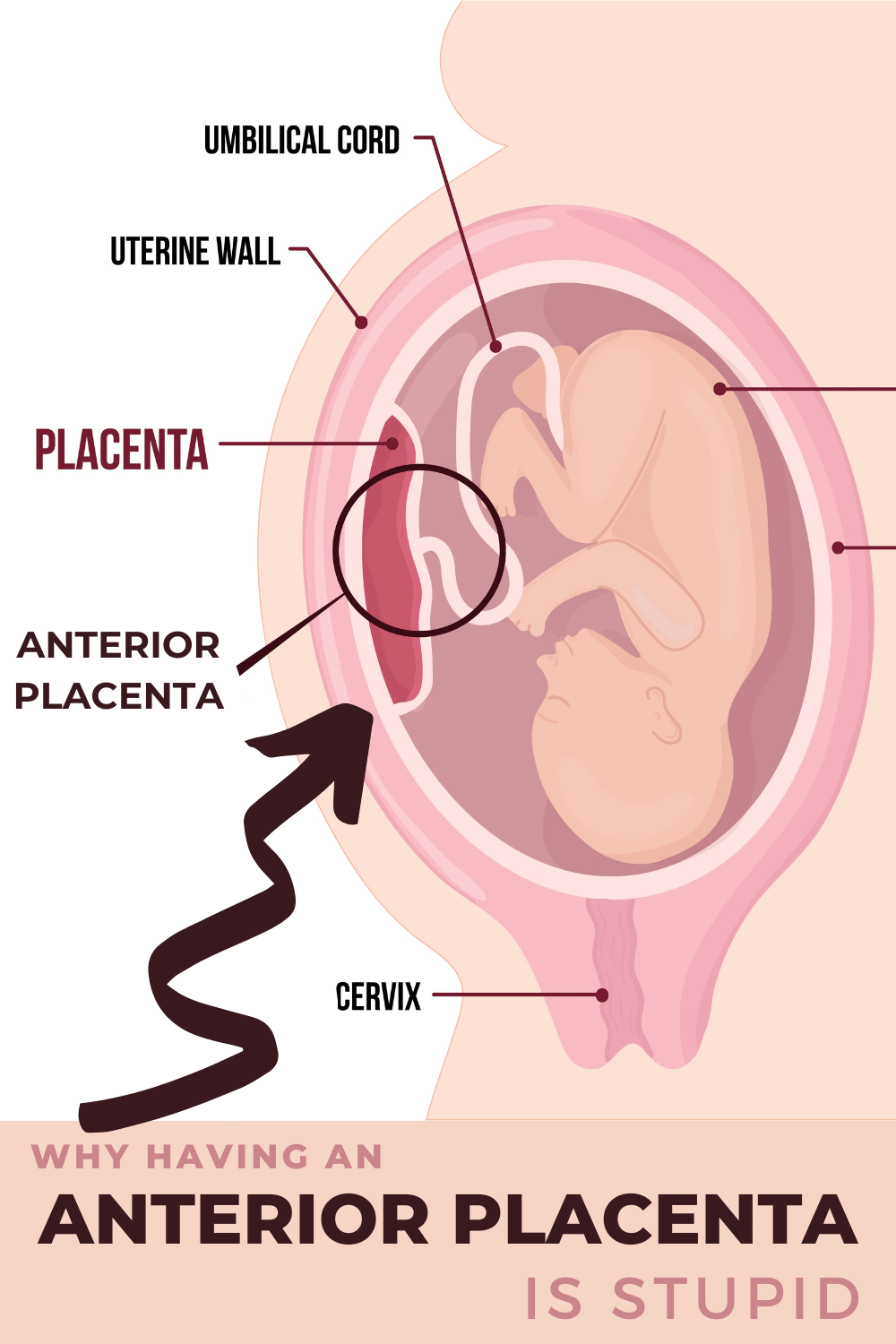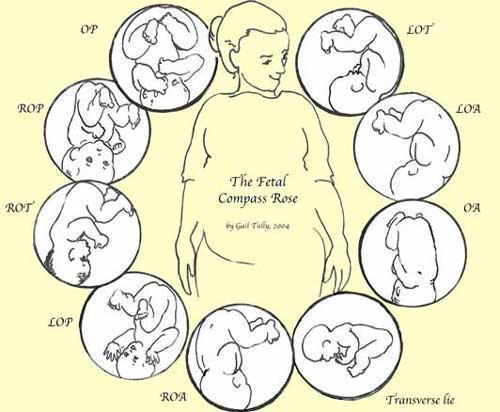What is an anterior placenta and what does it mean for pregnancy? In this post we’ll discuss the risks, complications, and the annoying things that go along with having an anterior placenta.
Many years ago at one of my 20 week anatomy ultrasound appointments I asked the tech where my placenta was located. She said I had an anterior placenta, to which I replied, “that’s stupid.” The ultrasound tech wondered why I said that, and maybe you wonder too. This post is everything you need to know about why I thought having an anterior placenta is stupid.
On This Page
8 minute read
↓What is an anterior placenta?
↓Is an anterior placenta normal?
↓Will an anterior placenta move to a different location?
↓Anterior placenta risks and complications
↓When will I hear baby’s heartbeat with an anterior placenta?
↓When will I feel movement with an anterior placenta?
↓Is it harder to determine baby’s position with an anterior placenta?
↓Will an anterior placenta make labor longer and more painful?
↓The 3 Principles of Spinning Babies
↓Will I need to have a cesarean birth because of my anterior placenta?
↓Will I Have a Bigger Belly with an Anterior Placenta?
↓Does Having an Anterior Placenta Mean Boy or Girl?
↓Is an Anterior Placenta Bad for Pregnancy and Birth?

What is an Anterior Placenta?
First, let me explain what an anterior placenta is. The typical placenta attaches itself between mom and baby but an anterior placenta attaches itself to the front of a woman’s uterus.
Every time I was pregnant I had an anterior placenta. So, if you came up to me when I was pregnant and rubbed my belly and started talking to the baby, you were in fact introducing yourself to my placenta and not the baby.
Anterior placentas are in the front of the uterus, right in between baby and the belly button.
Is an Anterior Placenta Normal?
The typical placement of a placenta is in the posterior position, not anterior. However, it is not abnormal to have an anterior placenta. An anterior placenta is a normal abnormality!
Will It Move?
No, an anterior placenta won’t move. Once the placenta is implanted it will stay where it’s at. Once an anterior placenta, always an anterior placenta.
However, for future pregnancies a woman could have the placenta implant in a different location altogether.

Ok, so having an anterior placenta isn’t necessarily “stupid” but more annoying than anything. And don’t get me wrong, I am grateful that I had healthy placentas keeping my babies healthy. (I’m also grateful that my placentas weren’t low lying which could be dangerous if it covered my cervix, aka placenta previa.)
The following are some risks, complications, and stupid/annoying things that go along with having an anterior placenta.
Anterior Placenta Risks and Complications
One of the reasons why anterior placentas annoy me is that it makes it extremely hard to hear baby’s heartbeat with a fetoscope or pinard horn in your second trimester.
What is a Fetoscope or Pinard Horn?
A Pinard Horn or fetoscope are like stethoscopes, but used primarily to hear fetal heart tones. It’s not invasive, doesn’t use ultrasound like a doppler, so anybody could use it without having to have a medically indicated reason.
However, since my placentas were always in the front I was never able to hear my baby’s heartbeat with my fetoscope. Instead heard my own pulse loud and clear. I was hearing my placenta!

When Can I Hear My Baby’s Heartbeat with an Anterior Placenta?
A big reason an anterior placenta can be frustrating is because in the first and some of the second trimester it could cause your care provider to struggle to find baby’s heartbeat with a handheld doppler. Because baby is still so small and the anterior placenta is in front covering baby, hearing baby’s heartbeat may not be possible.
Nothing is worse than waiting for your care provider to try to find the heartbeat. Even worse is when they’re not be able to find it! Typically, when this happens mamas go into “worse case scenario mode” and assume the worst.
However, the inability to hear a heartbeat with a doppler in the first and some of the second trimester is not uncommon.
This exact scenario happened to me right around the end of the first trimester when I was pregnant with my daughter. Instead of sending me on home and trying again in four weeks, my midwife was kind and sent me to get a quick ultrasound.
To my relief I saw and heard my baby. I also saw my anterior placenta! And it was at that point I knew I was REALLY pregnant! (Haha… if you’ve been there you know exactly how I felt!)

When Will I Feel Fetal Movement with an Anterior Placenta?
Another reason anterior placentas are frustrating is because it will typically take longer to start feeling fetal movement or quickening. On top of that, when women finally begin to feel movement, it can often be dulled compared to what other women may be feeling.
With an anterior placenta you might not feel movement WELL into your second trimester. This is frustrating, but normal!
With one of my anterior placenta pregnancies I started feeling movement at 16 weeks and my husband felt baby kick at 19 weeks. For me I don’t think having an anterior placenta impacted feeling fetal movement.
I did notice, however, that I only felt movement down low and to the sides, which makes sense because the placenta was cushioning any kicks I may have otherwise felt with a posterior placenta.

Is It Harder to Determine Baby’s Position with an Anterior Placenta?
Another reason I’m not a fan of anterior placentas is because I always look forward to figuring out my baby’s position (aka belly mapping) and an anterior placenta makes it a bit more difficult.
Because there’s a placenta in the way, an anterior placenta makes it more challenging for moms to figure out their baby’s position.

Will an Anterior Placenta Make Labor Longer and More Painful?
A quick google search will reveal that some people believe OP babies are more common with an anterior placenta. Uh-oh!
An OP baby is the occiput posterior position (head down and facing mom’s front). The optimal position, however, is occiput anterior which is head down and facing mom’s back. Having a baby in the optimal position makes labor shorter and less painful – a good thing!
If babies with anterior placentas are more likely to be in an un-optimal position, it makes sense to think that anterior placentas cause harder, longer, and more painful labors. Not good!

After consulting the Spinning Babies website I’ve concluded that no, an anterior placenta doesn’t necessarily mean baby will be in an un-optimal position resulting in a longer, more painful, and complicated birth. Especially if you apply the 3 principles of spinning babies to your pregnancy!
The 3 Principles of Spinning Babies
- Balance your uterus. 1-5 short inversions per day and the rebozo are your friend.
- Apply gravity using maternal positioning. Couches and recliners are for wimps!
- Move the mother. Pelvic rocks, swimming, and more inversions.
A good time to start implementing these things is around 20 weeks. Pregnant women should be doing daily inversions, stretching, pelvic floor exercises, gentle prenatal yoga, psoas exercises, brisk walking, and swimming!
The Daily Essentials video by Spinning Babies is probably the best resource I’ve found to prepare you and your baby for a less painful and more empowered birth experience.
SIDE NOTE: I gave birth to my daughter one day before her due date. Her labor was straightforward and I had no baby positioning problems or placenta problems. Everything went great!
Will I Need to Have a Cesarean Birth Because of My Anterior Placenta?
A diagnosis of an anterior placenta in and of itself is not a medically indicated reason for a cesarean section. In English – No, you won’t need a cesarean because your placenta is anterior.
Other placenta issues like placenta previa (where the placenta covers all or part of the cervix – not an emergency but you obviously cannot have a vaginal birth if the placenta is still covering the cervix at 40 weeks or full term), or placental abruption (where the placenta becomes partially or completely detached from the uterus – AN EMERGENCY!) would definitely be reason to have a life saving cesarean birth.

More Questions Answered
Will I Have a Bigger Belly with an Anterior Placenta?
Nope, your belly shouldn’t be any bigger with or without an anterior placenta. Every pregnant woman has the same stuff in her uterus, it’s just arranged differently!
Does Having an Anterior Placenta Mean Boy or Girl?
As fun as it would be to confirm that there are more boy or girl babies associated with anterior placentas, it’s just not a thing. Sorry!
Is an Anterior Placenta Bad for Pregnancy and Birth?
In conclusion, an anterior placenta is not bad for pregnancy and birth. It’s a normal abnormality and no cause for concern. I may think that it’s stupid 😉 but it’s really no big deal. Happy pregnancy to you!


Amber Douglas
Thursday 12th of June 2025
I agree this is my first pregnancy 36 weeks today only found out on memorial day that I had the placenta in the front I didn’t feel her move until 24 weeks and I got scared cause they said I need to feel her move 10 times an hour and I definitely don’t and when I do feel her is is only at the top sides and bottoms. I got worried at first and I was like I can’t afford to pay for parking everyday until I give birth in early July. But then the ER OBG side it’s normal to not feel her move as much due to having the placenta in the front thank you for your article and I found it on Pinterest
Paige
Thursday 6th of October 2022
I just found out I have a (stupid) anterior placenta and your article made me laugh and was very helpful, so thank you!
Lindsey VanAlstyne
Monday 10th of October 2022
lol you're welcome!
Beatrice
Sunday 21st of March 2021
You really should not have called an anterior placenta stupid...maybe a quick way to attract people to your article, but indeed a stupid way to behave. And disrespectful
Priscilla
Tuesday 23rd of June 2020
I am 20 weeks pregnant with twins. Baby A has posterior uterus and baby B has anterior uterus. I'm very scared because of what I've read in many articles about there possibly loosing the baby.
Neurognant
Sunday 26th of May 2019
This is my 4th baby. I had placenta priva leading to a placental abruption and emergency C-section with my first no issues with my 2nd and 3rd. My daughter however, passed away at 2months old and now I am pregnant again (suprise baby) but I have an Anterior placenta and it is driving me crazy not feeling her yet. By your 4th baby, you kind of know what to expect and when to expect to feel movement but Nooooo not this one. I'm a neurotic mess at this point worried something is wrong every 10 minutes thanks for the article! Really helped explain some things to me.